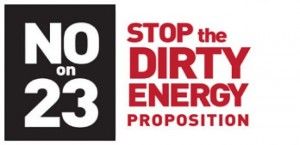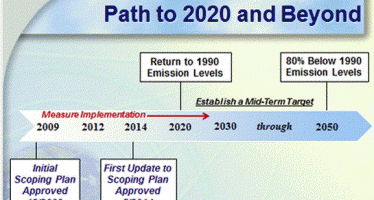Studies predict AB 32 will crash Calif. economy
By Dave Roberts
Two new studies are predicting economic devastation in California as the myriad regulations and costs resulting from AB 32, the Global Warming Solutions Act of 2006, take effect in the next eight years. The hit to state residents will total $35 billion in 2020 — exceeding California’s combined revenue from sales taxes, corporation taxes, insurance taxes, estate taxes, liquor taxes, tobacco taxes and vehicle fees, according to a study by Andrew Chang & Company for the California Manufacturers & Technology Association. The average family will pay an extra $2,500 by 2020 due to increased energy prices.
The total cumulative cost to consumers will be $136 billion by 2020, according to the report. California’s gross state product will be reduced by $153 billion, representing a 5.6 percent decrease. That is roughly equivalent to California’s GSP loss in the Great Recession from December 2007 to June 2009. In addition, the state will have 262,000 fewer jobs in 2020 than if AB 32 had not been enacted. Total state and local tax revenues will be reduced by more than $7.4 billion annually in 2020.
These figures are based on an “optimistic” scenario, assuming a lower range for fuel price hikes and a higher range for energy efficiency the reduction in vehicle miles traveled. The actual costs could be much higher: California families could be paying an extra $4,500 annually, while state and local tax revenue could drop $39 billion by 2020.
“These policies will create a large but hidden tax on families and will add new burdens to a fragile state economy,” said CMTA President Jack Stewart. “This new tax is not what we need while Californians struggle to find jobs, meet mortgage payments and maintain a reasonable quality of life. This poses great risks to manufacturers and other firms competing in regional and global markets. Current data shows that California already is lagging the nation in new manufacturing investment because of other cost pressures and uncertainties. The Legislature must use this critical data to get control of AB 32 costs.”
Hardest hit may be the state’s businesses, particularly those in energy-intensive areas like manufacturing, transportation and petroleum refinement. But all will feel the pain, according to National Federation of Independent Business/California Executive Director John Kabateck.
“For the past five years, small business owners have been concerned about their ability to operate under the potential costs of a complicated AB 32 regulatory scheme,” said Kabateck. “This comprehensive report tells us that small business will get hit from all sides. Consumers will have less money to buy our products, employers will be forced to purchase more affordable products outside of California and our own energy costs will make it nearly impossible to stay in business.”
‘Optimistic’ scenario
Under the “optimistic” scenario, California’s local governments will lose $1.9 billion in revenue by 2020 and face an additional annual cost increase of $2.3 billion in 2020, according to the report. The Los Angeles Unified School District will face cumulative costs of $27.3 million, with an annual impact of $5.5 million in 2020.
“Municipalities are struggling everywhere in California,” said Diamond Bar Mayor Ling-Ling Chang. “This is a double hit in both lost revenues and substantial new costs. I’m in favor of greenhouse gas reductions, but there must be a cheaper way to do this.”
On the plus side, the state is expected to meet its goal of reducing greenhouse gas emissions to 1990 levels by 2020. On the down side, one-quarter of those reductions “will be due to the economic slowdown resulting from AB 32 and the decrease in transportation fuel consumption due to increased costs and decreased earnings,” the report states.
The state’s outlook is not much better in the other report, which was prepared by The Boston Consulting Group for the Western States Petroleum Association. It’s key findings include:
* Gas prices could increase by $2.70 per gallon in California, depending on the cost of carbon.
* Due to refinery closures, California could lose 28,000-51,000 jobs, including many high-paying skilled manufacturing jobs, as well as indirect job losses due to multiplier effects.
* California could lose up to $ 4.4 billion of tax revenue per year by 2020.
* There will be a wealth transfer of at least $3.7 billion per year by 2020 from refineries and fuel suppliers to the California Air Resources Board as a result of purchasing allowances.
* California’s climate-change regulations will discourage energy intensive industries from locating in the state, and existing industry will have an incentive to leave the state.
“The findings of this research are sobering,” wrote WSPA President Catherine Reheis-Boyd in a June 18 letter to Gov. Jerry Brown. “Californians know all too well that, no matter how well intended, innovative energy policies may result in unintended consequences. CARB’s climate change regulations for fuel providers and fuels are exactly these innovative, first-of-their-kind policies that may result in serious and unintended consequences.
“From possible fuel shortages to an increase in global emissions to market disruptions reminiscent of the California energy crisis, the BCG study has highlighted some warning signs that require immediate attention by California policymakers. In order to safeguard Californians and fuel providers from the unintended but almost certain disruption of our state’s fuel supplies, it is essential that we begin a serious and constructive discussion on California’s fuels policies.”
Fuel supplies disrupted
Brad VanTassel, the lead researcher for the BCG study, said, “California’s current climate change policies pose some really impossible challenges for refiners in California that have the potential to disrupt fuel markets and fuel supplies in very serious ways. In addition to forcing the closure of a significant number of California’s petroleum refineries, those disruptions are likely to manifest themselves economy-wide in terms of lost jobs, higher costs for fuel, food and other necessities, and loss of tax revenues to state and local governments.”
With the AB 32 horse having left the barn — an anti-AB 32 proposition, Proposition 23, was defeated easily two years ago — state officials have largely ignored the studies in the belief that all will be well. They argue that additional energy costs will be offset by savings from increased energy efficiency, and that “green” jobs will be created to offset other job losses. CARB spokesman David Clegern estimates the state will save about $4.3 billion in health care costs from cleaner air by 2020, according to Green Supply Chain News. A CARB study in March 2010 concluded that AB 32 will reduce GSP (Gross State Product) by just 0.2 percent.
If the new studies are accurate, the economic pain from AB 32 will begin to be felt next year, and then will slowly ratchet up for the rest of the decade. In effect, Californians are the frog that’s been placed in a pot of warm water and the burner has just been turned on. In eight years the water will be at full boil. But by then it may be much too late to jump out of the pot.
Related Articles
CSU ‘student success fees’ an obnoxious surcharge
California lawmakers of both parties have long been upset that UC and CSU leaders look to raise tuition as option
PG&E Buying Spot In State Constitution
JUNE 7, 2010 By KATY GRIMES With PG&E spending $43 million on radio, television and print ads promoting Proposition 16,
Alternative fuel companies cheer, oil industry questions CA carbon regulations
The California Air Resources Board’s plan to renew the Low Carbon Fuel Standard elicited cheers at a recent Board meeting from its





